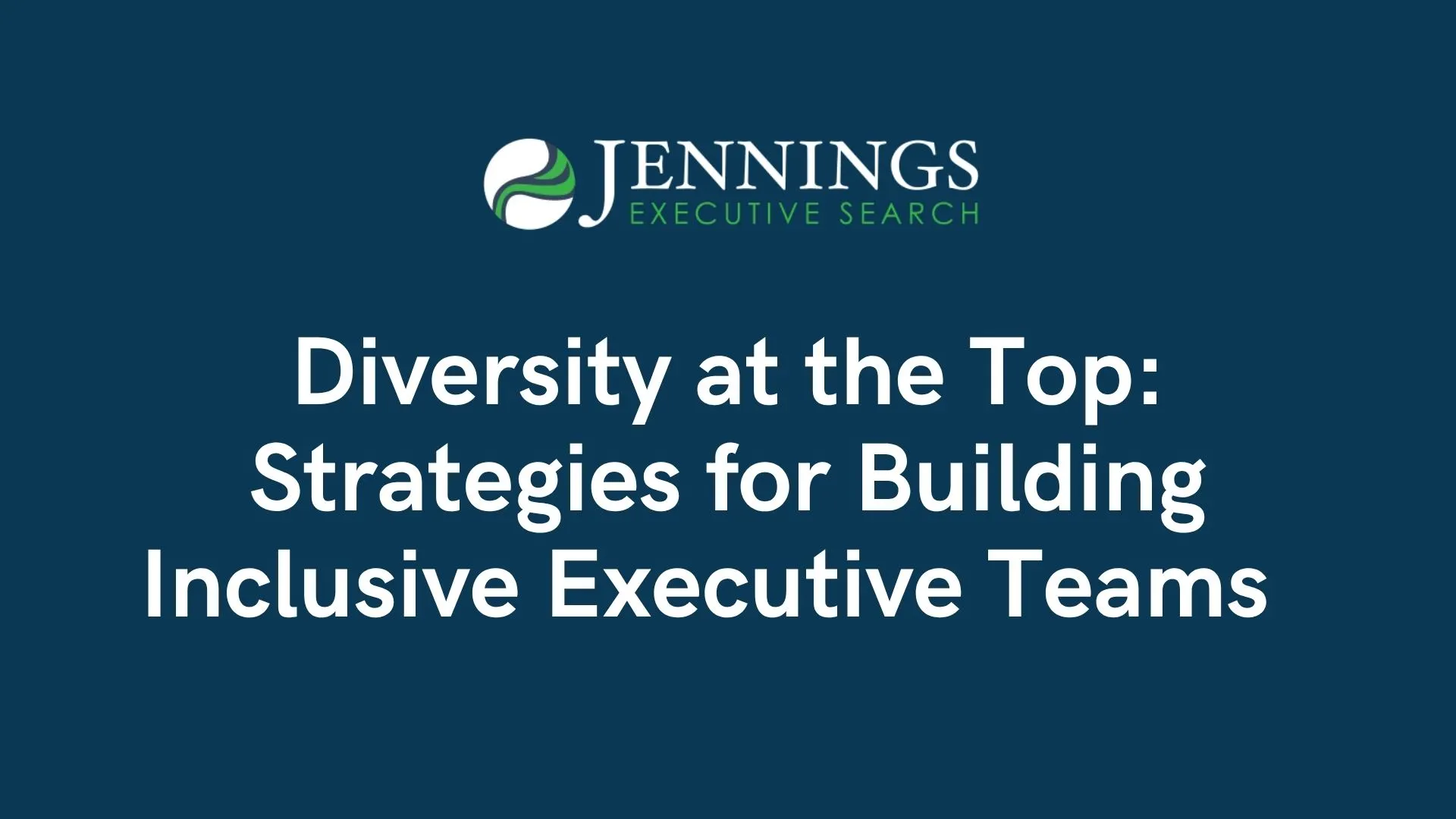Diversity at the Top: Strategies for Building Inclusive Executive Teams
Learn effective strategies for creating diverse and inclusive executive teams with our comprehensive guide.

In today's rapidly evolving business landscape, diversity at the top has become a critical topic of discussion. As organizations strive for innovation, adaptability, and success, it has become increasingly clear that inclusive executive teams are a key driver of these outcomes. In this article, we will explore the importance of diversity in executive teams, the current state of diversity in leadership, the barriers to building diverse teams, and strategies for fostering inclusivity at the top. By embracing diversity in executive roles, companies can enhance decision-making processes, improve company performance, and create a culture of inclusivity that attracts and retains top talent.
Understanding the Importance of Diversity in Executive Teams
In a globalized world where diversity is the new norm, it is essential for executive teams to reflect the makeup of their customers, employees, and communities. Research has consistently shown that diverse leadership positively impacts company performance, innovation, and profitability. Diverse teams bring a wide range of perspectives, experiences, and skills to the table, enabling more comprehensive decision-making and problem-solving. Furthermore, inclusive executive teams are more likely to foster a culture of creativity, collaboration, and employee engagement, leading to higher levels of overall success.
The Impact of Diverse Leadership on Company Performance
Companies that prioritize diversity in senior leadership positions tend to outperform their less diverse counterparts. Research conducted by McKinsey & Company found that companies with ethnically diverse executive teams are 33% more likely to outperform their industry peers in terms of profitability. Additionally, gender-diverse executive teams are 21% more likely to experience above-average profitability. These findings highlight the direct correlation between diversity in executive roles and financial success.
The Role of Diversity in Decision Making
One of the key advantages of diverse executive teams is their ability to make more informed and well-rounded decisions. When individuals with different backgrounds and perspectives come together, they bring unique insights to the table. This diversity of viewpoints helps challenge assumptions, uncover blind spots, and foster innovative thinking. By avoiding groupthink and embracing different perspectives, diverse executive teams are better equipped to tackle complex challenges and seize new opportunities.
Moreover, diverse executive teams also have the advantage of being more attuned to the needs and preferences of a diverse customer base. By having a leadership team that reflects the diversity of their target audience, companies can better understand and cater to the unique requirements of different market segments. This not only enhances customer satisfaction but also drives brand loyalty and market share.
Furthermore, diverse executive teams have been found to be more effective in managing and navigating cultural complexities in a global business landscape. In today's interconnected world, companies often operate in multiple countries and interact with diverse cultures. Having a leadership team that understands and appreciates different cultural nuances can be a significant advantage in building strong international partnerships, negotiating deals, and expanding into new markets.
The Current State of Diversity in Executive Teams
Despite the growing recognition of the benefits of diversity in executive teams, the current state of representation is far from ideal. Gender diversity remains a prominent issue, with women significantly underrepresented in senior leadership roles. According to a report by Catalyst, women hold only 29% of senior management positions globally. Ethnic diversity is also a challenge, particularly for underrepresented minority groups. This lack of diversity points to the need for concrete and targeted efforts to address the barriers and inequalities that hinder inclusive executive teams.
A Look at Gender Diversity in the Boardroom
The underrepresentation of women in executive roles is a persistent issue around the world. While progress has been made in some industries and countries, there is still much work to be done. Various factors contribute to this disparity, including unconscious bias, gender stereotypes, and the lack of female role models in senior positions. Recognizing the importance of gender diversity in driving organizational success, companies must actively strive to create equal opportunities for women to excel and lead at the highest level.
One way organizations can address the gender gap in executive teams is by implementing mentorship and sponsorship programs specifically designed to support the professional growth of women. These programs can provide guidance, networking opportunities, and access to senior leaders who can advocate for their advancement. Additionally, companies should prioritize diversity and inclusion initiatives that promote a culture of equality and provide training on unconscious bias to ensure fair and unbiased decision-making processes.
Ethnic Diversity in Leadership: Where We Stand
Achieving ethnic diversity in executive teams is another critical challenge. Minorities, particularly those from underrepresented groups, face systemic barriers that limit their advancement to top leadership positions. To build inclusive executive teams, organizations must implement measures to address unconscious bias in the hiring process, promote diversity and inclusion initiatives, and provide mentorship and sponsorship programs that support the professional growth of minority employees.
Furthermore, companies should actively seek out diverse talent by expanding their recruitment efforts to reach a wider pool of candidates. This can include partnering with organizations that focus on supporting underrepresented communities, attending career fairs and conferences that cater to diverse professionals, and implementing inclusive language and job descriptions in job postings. By proactively seeking diversity, organizations can create a more inclusive and representative leadership landscape.
Barriers to Building Diverse Executive Teams
Building diverse executive teams requires overcoming various barriers that hinder progress. Unconscious bias, often implicit and unintentional, influences decision-making and can result in the exclusion of qualified candidates from underrepresented groups. Additionally, organizations must address the challenge of retaining diverse talent. Creating an inclusive environment where diverse employees feel valued, supported, and heard is essential for building and maintaining a diverse executive pipeline.
Unconscious Bias in the Hiring Process
Unconscious bias can lead to the unintentional exclusion of diverse candidates during the hiring process. This can manifest in various ways, such as favoring candidates who share similar backgrounds or experiences, or making assumptions based on stereotypes. To overcome this barrier, organizations should implement structured and inclusive recruitment practices.
One effective strategy is to create diverse candidate slates, ensuring that a wide range of backgrounds and perspectives are represented. This approach helps to counteract the tendency to default to familiar or comfortable choices. Additionally, anonymous resume reviews can help remove any potential bias based on names, educational institutions, or other identifying information. By focusing solely on qualifications and experience, organizations can ensure a fair and unbiased evaluation of candidates.
Furthermore, it is crucial to provide training for hiring managers to recognize and minimize unconscious bias. This training can raise awareness of the different forms bias can take and equip managers with the tools to make more objective decisions. By fostering a culture of inclusivity and fairness, organizations can create a hiring process that attracts talent from a wide range of backgrounds and experiences.
The Challenge of Retaining Diverse Talent
Retaining diverse talent is crucial for building sustainable and inclusive executive teams. While attracting diverse candidates is an important first step, organizations must also focus on creating an environment that values diversity, encourages open dialogue, and offers opportunities for growth and advancement.
Mentorship and sponsorship programs play a vital role in supporting the professional development of underrepresented employees. Pairing diverse talent with experienced leaders who can provide guidance, support, and advocacy can significantly enhance retention rates. These programs create opportunities for meaningful connections, knowledge sharing, and career advancement. By investing in mentorship and sponsorship initiatives, organizations can nurture talent, build strong relationships, and create a more inclusive leadership pipeline.
In addition to mentorship and sponsorship, organizations should prioritize creating an inclusive culture where diverse employees feel valued, supported, and heard. This can be achieved through initiatives such as employee resource groups, diversity training programs, and inclusive leadership development. By fostering an environment where everyone's contributions are recognized and respected, organizations can ensure that diverse talent thrives and remains committed to the company's mission and goals.
Strategies for Building Inclusive Executive Teams
Fostering diversity and inclusivity at the top requires a deliberate and comprehensive approach. Organizations committed to building inclusive executive teams can implement various strategies to drive change and create a culture of diversity and inclusion.
One key aspect of fostering diversity within executive teams is to ensure that the leadership reflects the diversity of the wider workforce and customer base. This can help in bringing different perspectives to the decision-making table and better understanding the needs of a diverse range of stakeholders. By actively seeking out candidates from various backgrounds and experiences, organizations can enrich their leadership team with a broad spectrum of viewpoints and ideas.
Implementing Inclusive Recruitment Practices
Companies should adopt inclusive recruitment practices that attract diverse talent. This includes reaching out to diverse networks, partnerships with organizations focused on diversity and inclusion, and removing biased language from job descriptions. Furthermore, organizations should provide unconscious bias training to hiring managers to help them recognize and mitigate bias during the selection process.
Another crucial aspect of inclusive recruitment is ensuring that the interview panels are themselves diverse. Having a diverse panel can help in reducing biases during the selection process and ensure that candidates from all backgrounds are evaluated fairly based on their skills and qualifications. This approach can lead to a more inclusive hiring process and ultimately contribute to building a diverse executive team.
The Power of Mentorship and Sponsorship Programs
Mentorship and sponsorship programs are powerful tools for developing diverse talent and creating a pathway to executive roles. These programs pair senior leaders with high-potential professionals from underrepresented backgrounds, providing guidance, support, and advocacy. By investing in mentorship and sponsorship initiatives, organizations can cultivate a diverse leadership pipeline and empower individuals to reach their full potential.
Moreover, mentorship and sponsorship programs can also help in breaking down barriers that may exist for individuals from underrepresented groups in accessing senior leadership positions. By providing guidance, exposure to opportunities, and advocacy within the organization, these programs can play a significant role in leveling the playing field and ensuring that talent is recognized and nurtured regardless of background.
Measuring the Success of Diversity Initiatives
To ensure the effectiveness of diversity initiatives, organizations must establish key performance indicators (KPIs) that reflect the goals and objectives of their diversity strategy. These KPIs can include metrics such as representation in leadership positions, employee engagement surveys, and diversity training attendance. By regularly monitoring progress and analyzing data, organizations can identify areas for improvement, implement necessary changes, and ensure the continuous improvement of their diversity efforts.
Key Performance Indicators for Diversity Initiatives
Some key performance indicators for diversity initiatives include the representation of underrepresented groups in leadership positions, employee satisfaction and engagement levels, and diversity training participation rates. These measures provide valuable insights into the impact of diversity initiatives and help organizations track their progress towards building inclusive executive teams.
The Role of Continuous Improvement in Diversity Efforts
Diversity efforts should not end with the implementation of initiatives; they require continuous improvement and evaluation. By regularly reassessing diversity strategies, organizations can identify areas of strength and weakness and make necessary adjustments. This ongoing commitment to diversity and inclusion ensures that organizations stay aligned with evolving best practices and maintain momentum in building diverse and inclusive executive teams.
Conclusion
Diversity at the top is no longer a mere buzzword; it is a crucial factor in driving organizational success. Building inclusive executive teams goes beyond ticking boxes for representation; it is about leveraging diverse perspectives, experiences, and skills to enhance decision-making, innovation, and overall performance. Organizations that prioritize diversity initiatives, address barriers, and implement inclusive strategies are better equipped to succeed in today's rapidly changing world. By embracing diversity at the top, organizations can foster a culture of inclusivity, attract top talent, and position themselves as leaders in their industries.
If you're ready to elevate your organization's leadership with the power of diversity, Jennings Executive Search is your partner in this transformative journey. With our deep expertise in securing top-tier talent for senior-level positions, we understand the nuances of building inclusive executive teams that drive success. Discover how we've successfully placed leaders in roles such as Director of Pricing Strategy, Global Pricing Lead, and Sr. Manager of Pricing Strategy, and learn how we can do the same for your company. Learn More about Jennings Executive and take the first step towards a more diverse, innovative, and successful future.
Recommended For You

From Pricing To Enterprise Analytics
How pricing teams can evolve into enterprise analytics engines and drive broader value.

How to Spot Pricing Talent When You’re Not a Pricing Expert
Hiring pricing talent without pricing expertise is possible—focus on role-specific skills, real business impact, and situational thinking to assess how candidates drive margins and decisions.

The Hidden Burnout Risk In Pricing Roles
Pricing burnout is real: high conflict, low control—fix it with authority and systems.

Talent Benchmarking for Pricing Roles
Align pricing role scope, title & comp with real market benchmarks before hiring.

The Pricing Analyst's Toolkit
The essential pricing analyst toolkit—and what truly drives impact in the role.

Why Your Pricing Team Can't Be All Strategy Or All Execution
Pricing teams break when strategy and execution are out of balance—here’s how to fix it.


